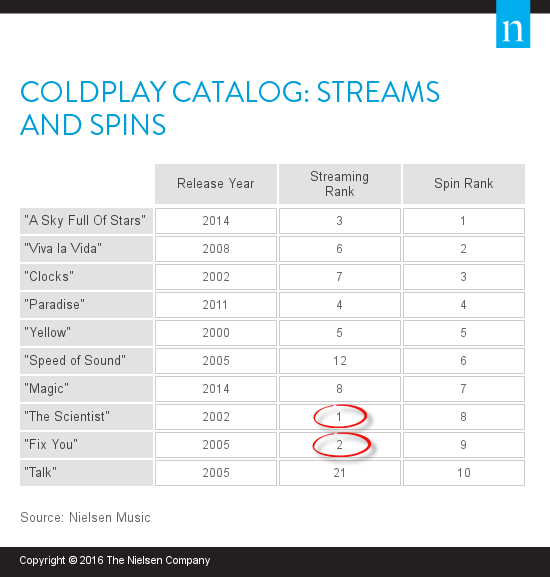While the audio landscape continues to grow, and streaming services compete with AM/FM radio for audience’s time and attention, there’s no denying that radio leads all platforms when it comes to reach. Nielsen’s most recent Comparable Metrics Report confirms that 93% of all adult consumers listen to radio on a weekly basis, more than they engage with TV or their smartphones. On the flipside, streaming is riding an undeniably massive growth swell. So what if radio programmers could benefit from the surge in streaming rather than fear it?
Truth be told, they can.
Streaming has changed the entire audio landscape. Music is no longer exclusively packaged in pre-made formats like a CD or radio playlist. On-demand streaming is personalized, portable and everywhere. And the sheer volume of streaming taking place is evidence that consumers can’t get enough.
So how can this help radio? In short, on-demand streaming tells us which music appeals to people. When music listeners purchase or download a song, we don’t know how many times they listen to it—if at all. With streaming, we know each time a play is initiated, day after day, week after week. The data is not from a sample, a listening room or a panel. It’s an un-aided, authentic look at the songs listeners are choosing.
Staying In Step With Listener Desires
The value of streaming for radio isn’t that it’s big or growing. The value is that it’s a clear record of listeners’ choices. And for programmers, the relationship between airplay, sales and on-demand streaming is key. Streaming and radio follow each other, and following the peaks and valleys that make up listener preferences can help programmers find the next hit, determine when to stop spinning a track and assess overall playlist strength.
In an effort to illustrate the relationship, Nielsen recently analyzed the spin, sales and streaming trends for singer-rapper Bryson Tiller’s “Don’t.” While Tiller had developed quite a name for himself by the end of 2015, he got his start in the on-demand streaming space in early February. Back then, fans of the young artist were listening to an average of 30,000 streams each week, and that trend continued through early May. Between May and late June, on-demand streams averaged 400,000 per week, but the song hadn’t made it to the radio yet. Radio picked up on the swell June 29, but the number of spins was nowhere near in line with on-demand streams. In fact, the song was streamed 1.4 million times during the week the song hit 100 radio spins. By the time radio committed, fans were streaming the track 3.5 million times per week. With the additional exposure on the airwaves, on-demand streams continued climbing, eclipsing 4 million by mid-October.
Keeping an eye on streaming trends can also help programmers manage their playlists from one hit to the next. This can be particularly helpful when new artists break out with a song and programmers need to know which subsequent tracks have legs and when to start playing them.
In the case of Bryson’s “Exchange,” the follow-up to “Don’t,” the data shows how the track gained momentum in on-demand streams while “Don’t” was still hot. Despite being streamed more than 2 million times per week, “Exchange” was getting very little radio airplay. When we look at weekly data, we see that the track ranked No. 66 among streamed songs, but it was 4,043 in radio airplay rank.

When programmers have true consumption data, they can be less reliant on following timelines prescribed by others, including labels and the media. In the case of singer-songwriter Demi Lovato’s “Confident,” the follow-up single to “Cool for the Summer” from last year’s Confident release, radio airplay didn’t line up with consumption trends. The song was also leading in sales with a rank of 15, while “Cool for the Summer” had slipped to 53 in terms of sales.

In a contrasting example, consumption data shows how radio maintained the number of spins for “Stitches” by Shawn Mendes when on-demand streaming was declining.

iT’S NOT JUST ABOUT What’s New
Tapping in to on-demand streaming data can also give programmers a sense of how they’re doing with respect to playing songs that aren’t new, but still have massive appeal. For example, Coldplay fans streamed “The Scientist” 928,597 times, yet the song was ranked No. 1,603 in terms of radio airplay. Comparatively, the band’s “Clocks” ranked No. 160 in terms of airplay but had only been streamed 567,312 times, highlighting about one-third less listener demand.
When we look beyond the year of release, as “Clocks” and “The Scientist” were released on A Rush of Blood to the Head in 2002, we see additional programming opportunities within the Coldplay catalog. In fact, we see that “The Scientist” and “Fix You” were the two most streamed Coldplay tracks but ranked at the bottom of the list of Coldplay tracks in radio rotation.

As with any market, there is no single solution or silver bullet to ensure across-the-board success from a radio programming perspective. But with direct insight into what people are listening to, programmers essentially have the recipe for building the most desired playlists.



